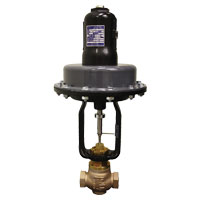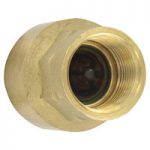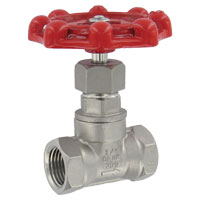Gas valves
Gas valves are the gas flow control products (liquefied gas, oxygen, natural gas, etc.) which are used in gas cylinders, oil and gas industry piping networks, oxygen cylinders and the other compressed gases. Gas valves are made of raw materials such as different types of metals or plastics. Choosing the gas valves material, depends on the compatibility with the controlled gas and its pressure. Actually, the used material should have the least reactivity against gas and have the needed resistance against possible expansion and contractions.
The difference between gas and water valves
The difference between opening and closing gas and water valves: unlike water valves, the flow control modes in gas valves are open and close and there is no intermediate mode. Also, due to the importance of gas flow control speed, gas valves are opened and closed with only a quarter turn.
Different types of gas and water valves: Choosing the raw materials of the gas valves is more important because of the high pressure and most of gas flows reactivity. Common materials used in producing gas valves are steel, brass, bronze, chrome, titanium, PVC, CPVC and PFI Lined.
Can gas and water valves be used interchangeably?
Due to the differences between gas and water valves and the importance of the special design of gas valves to be safe, only suitable gas valves can be used to control the gas flow. But there is no limit to use gas valves for controlling water flow, and even considering the advantages of gas valves, using them instead of water valves is more logical in some cases. This idea is more affordable in some cases due to the higher quality of gas valves, the speed of liquid flow control and also helps to avoid wasting water.
Gas valve types
1 – The control valves: These valves are widely used in gas pipelines in oil and gas industries. The gas flow in these valves is controlled according to parameters such as pressure, temperature and gas speed. In these valves, the flow outlet is automatically or remotely measured and adjusted by using a hydraulic, pneumatic or electric signal.
– The control valves: These valves are widely used in gas pipelines in oil and gas industries. The gas flow in these valves is controlled according to parameters such as pressure, temperature and gas speed. In these valves, the flow outlet is automatically or remotely measured and adjusted by using a hydraulic, pneumatic or electric signal.
2 – Butterfly valves: Butterfly valves are used to isolate and adjust flows with low pressure. These types of valves usually have a low thickness, which makes it useable in any structure. These valves have a high reaction speed in opening-closing and factor of safety.
– Butterfly valves: Butterfly valves are used to isolate and adjust flows with low pressure. These types of valves usually have a low thickness, which makes it useable in any structure. These valves have a high reaction speed in opening-closing and factor of safety.
3- Plug valves (ball valves): Plug valves are widely designed to control the gas flow and high pressure liquids. These valves have high opening and closing speed, low torque and ball locking power to control gas or fluid flow. Ease of use, high resistance, easy repair and also adaptability to various connections, causes the wide use of plug valves.
4 – Check valves (globe valves): Check valves provide the possibility of fluid passing in only one direction, as a result, their use is to prevent returning the fluid to the pipes. The use of check valves is necessary to protect pumps and reduce damages and costs as a result of the flow reversing.
– Check valves (globe valves): Check valves provide the possibility of fluid passing in only one direction, as a result, their use is to prevent returning the fluid to the pipes. The use of check valves is necessary to protect pumps and reduce damages and costs as a result of the flow reversing.
5 – Globe valves (with handle): Globe valves have the both flow opening and closing and flow isolation usages. In this type of valves, simple linear movement allows quick opening and closing. This valve is easily to install and designed in such a way that it has the possibility of repairmen at the installation location. Due to its widespread use in the industry and the high production of this product, its spare parts are available.
– Globe valves (with handle): Globe valves have the both flow opening and closing and flow isolation usages. In this type of valves, simple linear movement allows quick opening and closing. This valve is easily to install and designed in such a way that it has the possibility of repairmen at the installation location. Due to its widespread use in the industry and the high production of this product, its spare parts are available.
Which industries are using of gas valves?
Gas valves are used in various industries and for various applications. Some of the gas valves usages are:
- Aerospace
- Agriculture
- Automotive
- Construction
- Fire services
- Flood control
- Food processing
- Medical
- Mine
- Oil
- Power generation
- Pulp and paper
What materials are used to produce gas valves?
Various materials are used to produce gas valves, which are mostly aluminum, copper, brass and steel.
- Aluminum: Valves made of aluminum have a good electrical and thermal conductivity. On the other hand, they are resistant to oxidation, so you can be sure of their durability for industrial use.
- Copper: Due to high flexibility, copper is suitable for producing all kinds of gas valves.
- Brass: It has high durability and low magnetic permeability. The flexibility of brass is high and therefore the use of brass in the production of faucets makes the casting process easy.
- Steel: Steel has high chemical resistance and is stainless.
The advantages of using brass in producing gas valves:
- The high heat resistance of brass is a positive feature for using in industries and products when there is a possibility of heat increase. On the other hand, brass can withstand minus 204 degrees Celsius. Therefore, it is possible to use brass valves in different climates and industries.
- Brass has a higher physical resistance than plastic, and its damage is more against frequent pressures.
- Compare to the other metal materials used in gas valves, brass has the least amount of lead. Therefore, brass valves can be used even in water piping networks. According to the chemical composition of brass, its environmental pollution is also lower in case of lead pollution.
- Brass valves have high chemical resistance and are resistant to corrosion.
- The high flexibility of brass makes the various production processes easy such as casting. Despite its high flexibility, there is no limit to the implementation of complex designs on brass, and it can be used for all models of faucets and devices.
- Compared to other materials, brass has a lower cost. As a result, brass products are more affordable despite their good quality.



